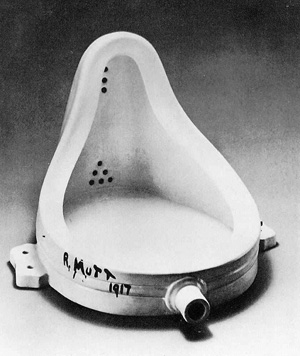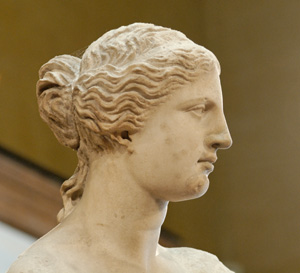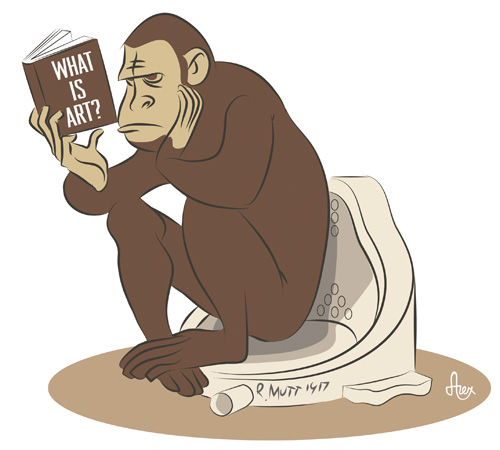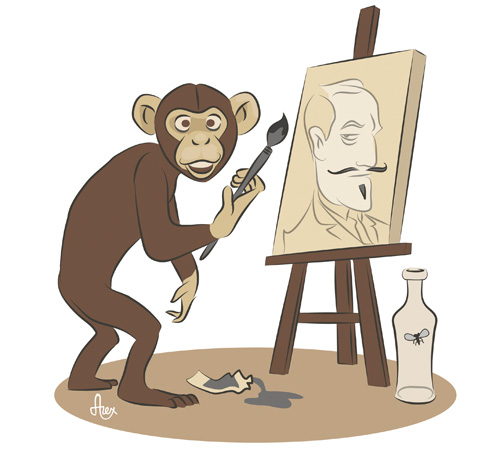
Your complimentary articles
You’ve read one of your four complimentary articles for this month.
You can read four articles free per month. To have complete access to the thousands of philosophy articles on this site, please
The Art Issue
The Hard Case of Duchamp’s Fountain
Launt Thompson argues that some popular trends in art criticism are fallacies.
Aestheticians are a fractured lot. A survey of the many thousands of papers and books published on aesthetics will confront the reader with a cacophony of ideas from philosophers who are described as Functionalists or Proceduralists or Institutionalists, even as Expressionalists and Representationalists – each earnestly seeking to offer the penultimate word on the question ‘What is Art?’ I say ‘penultimate’ because even philosophers recognize they are only human and subject to error. They offer their ideas so that they may be extended and advanced by others of like mind. Nevertheless, aesthetics, which was once simply defined as the exercise of taste and the appreciation of beauty [‘aisthetikos’ is old Greek for ‘perception’, Ed], has been kneaded, twisted, turned, flailed and even sautéed in an effort to cook up a theory that will account for all the many permutations of art that contemporary artists produce. Of course, in order to maintain their personal theories, some of the more traditional aestheticians merely deny that many of the oddities offered as art are examples of art. It seems that in such cases it is the artist who is at fault rather than the theory that attempts to explain art. No doubt there are many attempts to make new art-forms that fail (the ‘Happenings’ of the 60s are an example); but aestheticians can take no credit for their failure.

Fountain
The esoteric nature of most theories of art prevent them from being absorbed and understood by the art-going public, who on the whole have little interest in philosophy. Many merely desire a pleasant afternoon perusing the exhibitions in their local gallery. For some it is an opportunity to discover what it is that everyone is talking about; but few are concerned with why such talk is taking place. Although many may hold a tacit theory about what counts as art, which they feel is sufficient to distinguish works of interest from works of no importance, they would not desire their theory to be publicly exposed and tested, and understandably so. Though some may read the wisdom of art critics in newspapers and magazines, or listen attentively to gallery tour guides, art appreciation still tends to be a private activity.
The point is that it is not aestheticians, critics, or tour guides that are most responsible for the longevity of our art works. Rather, it is artists and the tacit opinions of the art-going public that ensure the endurance of art. And before institutional public exhibitions of art became commonplace, artists’ studios were turned into galleries and were often visited by those who could not afford or did not desire to buy art.
So does philosophical aesthetics really have a place, or is it merely whistling in the dark, alone and fearful of its irrelevance? I vote for the latter, and the arguments of recent aestheticians strengthen my view. For example, the notion of an ‘aesthetic experience’ is no longer seen as the product of ‘disinterested attention’ allowing for an emotional response to a work of art (cf Immanuel Kant). Rather, as the New Zealand aesthetician Stephen Davies argues, an aesthetic experience is fundamentally cognitive (see Definitions of Art, 1991, p.59). It entails understanding and the ‘grasping of connections’, and the only reason it is described as ‘aesthetic’ is because it is applied to art works. In other words an aesthetic experience is no different from any other contemplative experience. What is different is the reward obtained.
This is a long way from the Psychical Distance Theory of Edward Bullough, or the Institutional Theory of George Dickie. But while Davies is on solid ground with his view of aesthetic experience, his ground is actually an island, afloat in the unpredictable, swirling sea of aesthetic theorizing; a sea awash with the flotsam and jetsam of ideas that were once the flagships of aesthetic philosophy. Nevertheless, sincere aestheticians continue with their studious search for the essence of aesthetics without realizing, as Trevor Pateman argues, that their subject matter now has little to do with their subject (see his A Guide to Aesthetics, Criticism, and the Arts, 1991).

A more traditional statue: Venus de Milo
The subject is art and its works, and it is to the fundamentals of art-making we must look if we wish to philosophically unpack the ‘hard cases’ that tend to sink aestheticians. A philosophy of art must tell us what objects may be called art, and why. The task of critics is to pick up where philosophers leave off, and tell us if the art object in question is worthy or not, and why. Aestheticians tend to confuse and merge the practice of philosophy with the practice of criticism, and demonstrate their perspectives with exemplary cases that have had years of public certification, rather than with controversial works such as Duchamp’s Fountain, Warhol’s Brillo Boxes, Damien Hirst’s The Physical Impossibility of Death in the Mind of Someone Living, or Tomoko Takahaski’s Rubbish. To be sure, some aestheticians have contrived convoluted theories in an attempt to include such works in their philosophy, but the esoteric nature of their arguments makes them unintelligible to all but a patient few.
Three Fallacies of Aesthetics
There is a better way. But before this way is demonstrated, we must unpack three great fallacies of aesthetics. They’re widespread interdependent claims about art, and to demonstrate the fallacy of one will show the weakness of the other two.
The first fallacy is that art works possess the quality called ‘creativity’. This is most often expressed by the statement that ‘works of art are creative.’ But creativity (as opposed to creating) is not a making activity, it is a thinking activity. This is one reason that artists experiment with conceptual art. Yet although it may be hard for some to swallow, creativity no more exists in a painting (say) than color exists in a painting. Color exists in the perceiver’s response to light of various wavelengths, and the pigments in paintings merely reflect particular wavelengths, which the eye allows the mind to see as the color. So too the creative act takes place in the mind of the viewer, and is often accompanied by the shock of recognition. This is why I find no objection to Davies’ insistence that appreciating art is fundamentally the cognitive act of grasping connections. Therefore, when someone describes a work as ‘creative’ they are saying something about themselves, or perhaps about the artist. This may also be true when a work is described as ‘lacking creativity’. But could anyone recognize creativity if they did not have the capacity to think creatively? Given time, ten thousand monkeys pounding on keyboards may be able to write one of Shakespeare’s sonnets, but if they do, who recognizes the deed?
Philosophically, ‘creativity’ is not a defining condition for categorizing a work as ‘art’, although it may play a role in the criticism of particular works – that is, it may be used to describe some works as good and some works as bad.
If my first argument has been persuasive, then the second fallacy will be seen to be superfluous.
The second fallacy is that works we call art must be artifacts: they must be man-made. Found objects, and paintings by cats, elephants and monkeys are excluded. Yet if we accept that creativity exists in the mind of the viewer, we can understand that art need not be man-made. The postulate that they must be is coveted by some aestheticians to honor the supremacy of human activity. But the supremacy of human activity is human cognitive activity, and it is not lessened or devalued by cognitively appreciating art works that are not man-made.
The third fallacy is that art must have a point. For aestheticians, the point of art is to satisfy some aesthetic function, and if a work has no aesthetic function then by definition it is not a work of art. But the point of art is that it is art. Although this may sound circular, let me try to demonstrate the contrary.

Art ape images © Alex Lawrence 2015 Please visit preposterous.carbonmade.com
Forms of Art
The term ‘art’ can be used in a number of different ways, each with a different meaning or sense. Some may use the term honorifically, as when viewing a painting they exclaim: “Now that’s what I call art!” The term may also be used ironically or metaphorically. Most uses of the term, however, are in its classificatory sense – implying that all art works or art forms are to be classified under one heading. In discussions about art, it is easy when presenting an argument to unknowingly jump from the classificatory sense to the honorific sense of the term. For this reason let me specify that I shall be using the term ‘art’ in its classificatory sense.
In its classificatory sense, the term ‘art’ is shorthand for the term ‘art form’: that is, asking ‘Is it art?’ is short for asking, ‘Is it an instance of an art form?’ An art form is a category term that gathers works together based on the medium used and the manner of application. Thus, theatre is an art form, as is oil painting, stone sculpture, dance, literature, etc. Art forms also contain subheadings which distinguish particular works according to their genre, style or school of presentation. As designators of categories, art forms are sui generis – they are unique and have no counterpart in any other categorical system.
Aristotle was the first to recognize this, 2,500 years ago. Aristotle insisted that all works of art have a Medium of presentation, a Manner of presentation, and an Object of presentation. These three aspects of a work allow us to determine its art form – the category of art in which it is placed. It is also one reason why we seldom confuse everyday items with works of art.
We distinguish one art form from another by attending to each of these three aspects for the works in question. For example, an oil painting and a water color are different art forms: while each may present the same subject (the same view of a castle, say), they involve different media, which require different methods of application; and so involve different manners of presentation, too. The medium of a work is most often our means of identifying its form.

Open Art Surgery
Given this brief description of form, we are now ready to unpack one of those ‘hard cases’ that plague aestheticians.
When Marcel Duchamp (1887-1968) entered his Fountain, a urinal, in the 1917 Armory Art Show, where it was placed in the open sculpture section, it outraged many and was widely ridiculed. Critics and patrons did not recognize its art form. But today it is considered the flagship of the art form known as ‘ready-mades’.
With this work Duchamp is turning a pun into art (he published two books on puns) – he was ‘taking the piss’ out of those who held that art had to be aesthetically pleasing. Duchamp was rebelling against the practice of aestheticians of the day by choosing to present an easily-identifiable everyday item as art. The medium of ready-mades is usually objects that have been manufactured, but in such a context that they’re divorced from their utilitarian role. In this instance Duchamp used a porcelain urinal, but the artist up-ended it and presented it in a manner to which we are unaccustomed, with the water inlet facing us. The catchment area containing the drain holes also is upright also facing us. In this position the opening is shaped as a drop of water, reflecting its title. Clearly the artist was presenting us with an uncommon view. We are not expected to see it as a functional item. The artist is telling us that this item has another aspect.
In Aristotle’s terms, the medium is obvious. It is a porcelain urinal. The manner of presentation is also clear: the urinal is up-ended, placed on a pedestal, and painted with a mock signature, presenting us with a new perspective. Its object or subject matter is clear, too: as a fountain can be a urinal, so can a urinal be a fountain. The work is an articulate exposition of itself as art, reminding us that the enjoyment of art is lost when we become too pompous. Fountain was offered as a humorous work with serious implications. The title acts as a trigger allowing us the freedom to laugh with the artist. Humor in art often requires of us as much intellectual rigor as non humorous works.
The signature, ‘R. Mutt’, along with the date ‘1917’, serve a dual purpose. ‘Mutt’ is a slang term (short for ‘mutton-head’) which became part of the American vernacular around 1901. Duchamp was mimicking the artist’s tradition of signing and dating his or her works; he was also implying that any mutton-head could make a work of art.
But could anyone have done this? This is doubtful. Duchamp was the thinking man’s artist. He was a philosopher of art who chose to open the artistic Pandora’s Box to show us that experimenting with new forms was as reputable as experimenting with established forms. The shock of recognition lies in our ability to see that the artist was right.
It is not important to our understanding of art that Duchamp did not make this notorious work himself. Many great artists of the past, including Michelangelo, Rembrandt, and da Vinci, employed other artists who contributed to their works. The artist who initiates the work is the one credited for it.
No doubt some of you will now be quietly saying to yourself: “This fellow has drawn a very long bow!” I would ask you to take note of the fact that we do not preserve works merely because they are great works of art. In this instance the work foreshadows several major movements in art. It is of seminal importance and as valuable to art as the first prehistoric rendering of a hand print on a cave wall.
© Launt Thompson 2015
Launt Thompson was past head of the Department of Theatre Studies at the University of New England, New South Wales, Australia, and is now retired and living in New Zealand. He has written a Kindle book, Art: Showing The Fly The Way Out Of The Bottle.









